Electric bike range is without a doubt one of the main factors buyers consider when choosing their next ebike.
Unfortunately, more often than not, the range estimates provided by manufacturers are inaccurate and don’t reflect real-world riding conditions.
The last thing you want is to learn this the hard way—running out of power in the middle of a ride and having to pedal back home with no assistance (UPHILL!)
Luckily, there’s a quick way to get a real-world estimate of your ebike’s range with a simple formula we’ll explain below that takes into account the numerous factors that affect how far you can go.
Factors That Impact Electric Bike Range
One of the main reasons manufacturers’ ebike range estimates are often unrealistic is that there are just too many factors that affect how quickly your battery drains.
Some of the most obvious ones include the rider and cargo weight, terrain, wind, assistance level, and throttle usage.

Carrying additional weight on your ebike will decrease the range. (Image courtesy: ternbicycles.com)
Electric bike weight is very important when discussing the range. It’s no surprise that a 250-pound rider will use more battery power than a 170-pound rider, especially when riding in a higher assist level, using more throttle, and tackling hilly routes with strong headwinds.
Other important factors to consider include the type of tires you’re using, tire pressure, fitness level, outside temperature, and riding position.
For example, riding an ebike with fat tires on paved roads is inefficient and will drain the battery faster than using narrower trekking tires, especially if the tires are not inflated to the recommended pressure. Additionally, ebike batteries tend to drain more quickly in colder temperatures, so you’ll get a higher range estimate on warmer days.
Your riding position has a major effect as well, as riding in an upright, non-aerodynamic position requires more motor power to overcome wind resistance than riding in a more aerodynamic position, such as that provided by an electric road bike.

Fat-tire electric bikes are great for off-roading and snowy weather rides, but are not the most efficient on smooth city streets. (Image courtesy: quietkat.com)
Lastly, there’s a notable difference in efficiency between rear hub motors with speed/cadence sensors and mid-drive motors with torque sensors (you may want to read our guide on hub motor vs. mid-drive motor differences).
Mid-drive ebikes are generally more efficient because they transfer power directly to the cranks, allowing you to utilize the bike’s gears to make your battery use more efficient.
So, how can you get a realistic estimate of your electric bike’s range, taking into account all of these factors? It’s actually much easier than you might think.
How to Calculate Electric Bike Range
To determine your ebike’s range, the first thing you need to do is find out what your battery capacity is in Watt-Hours (Wh).
Most manufacturers have this number readily available on product pages on their websites, but you can also calculate it on your own by multiplying the battery’s Voltage by Amp-hours. For example:
48V x 14Ah = 672 Wh
Now that we know what your battery capacity is in Watt-Hours, we need to divide that number by your ebike’s average efficiency in Wh/miles, which will tell us how many miles you can travel on a single full charge.
Total Wh / Wh/mile = Estimated Range
Now, getting the right Wh/mi estimate is the trickiest part that most ebike manufacturers get wrong because they don’t account for all the real-world factors that we’ve outlined above.
Our experience has shown us that a 175-pound rider riding on relatively flat terrain and on a calm day with little wind uses around 25 Wh/mile with throttle only. That would give them a 26.88-mile estimated range using the formula above.
672 Wh / 25 Wh/mile = 26.88-mile range
When riding with mid-level pedal assist, without the throttle, the efficiency estimate is around 15 Wh/mile, which gives us a 44-mile range.
Tweak the Numbers to Account for Additional Factors
You can now take the abovementioned factors into account and tweak the Wh/mi estimate for your real-world situation.
For example, riding in lower pedal assist levels will probably get you closer to 10 Wh/mi or below if you stay in Eco mode all the time.
Likewise, if you’re a heavier rider you may want to use a number closer to 30 Wh/mi on throttle only or 20 Wh/mi on mid-level pedal assist.
If you ride a hilly route or regularly deal with strong winds, you should take that into account as well.
While the results will never be 100% correct (because there are just too many factors involved), you’ll get a pretty realistic estimate of what you can expect and avoid running out of power in the middle of a ride.
Top Tips to Improve Electric Bike Range
The good thing about having so many factors influencing how far you can ride on a single charge is that there are a lot of things you can do to improve your electric bike range.
Here are some of our top tips.
1. Pedal More to Boost Electric Bike Range
The most obvious way to increase your electric bike’s range is to pedal more. Pedaling not only helps to conserve battery power but also gives you a good workout.

Pedaling as much as you can will greatly increase your range because the motor will have to work less and use less battery power. (Image courtesy: statebicycle.com)
To make the most of your pedal power, ensure that your bike is in the correct gear and adjust your pedaling cadence accordingly.
You should also make sure to pedal when you accelerate, especially when you’re starting from a complete stop, as this is when the motor works the hardest and uses the most battery power.
2. Use Correct Tires and Tire Pressure
The type of tires you use and the pressure they are inflated to can significantly affect your electric bike’s range.
Using tires with low rolling resistance and ensuring they are inflated to the correct pressure will reduce the amount of power needed to propel the bike forward, thereby extending its range.
For example, if you’re predominantly riding on paved roads and city streets, you should use narrower trekking tires instead of fat tires. The latter are more comfortable, but they create a lot more resistance and lower battery efficiency.
3. Use Correct Pedal Assist Level
Most electric bikes come with multiple pedal assist levels, each providing varying degrees of motor assistance.
Using the correct pedal assist level for the terrain you’re riding on can significantly improve your electric bike’s range.

For instance, if you’re riding on a flat road, you may not need as much motor assistance as you would when climbing a hill. Therefore, on flat roads, stay in lower pedal-assist levels and pedal a bit harder.
If the road starts going up, you can up your assist level to get more power from the motor and then lower it when you hit a descent.
4. Go Easy on the Throttle to Improve Electric Bike Range
The throttle is one of the most energy-demanding features of any electric bike.
While it may be tempting to use the throttle to cruise along without pedaling, it can quickly drain your bike’s battery.
- Related post: E-Bike Modes Explained: Throttle vs. Pedal-Assist
Instead, use the throttle sparingly and combine it with pedaling to conserve battery power.
The best times to use the throttle are when you’re starting from a dead stop, when you need to accelerate quickly, or when you’re climbing an exceptionally steep hill.
In all other cases, try to use it as sparingly as possible and your range estimate will go through the roof.
5. Maintain Your Drivetrain
A lot of ebike riders don’t take this into account, but a well-maintained drivetrain can significantly improve your electric bike’s range.
Ensure that the chain is clean, lubricated, and properly tensioned. A dirty or worn chain can cause unnecessary friction, requiring more power to pedal the bike.

Belt-drive ebikes have a maintenance-free drivetrain which improves ebike range in the long run. (Image courtesy: prioritybicycles.com)
Depending on how often and how much you ride, we recommend cleaning and lubricating your chain at least once a week and after every ride in the rain.
Of course, that’s unless you have a belt-drive electric bike, in which case the drivetrain requires zero maintenance.
6. Ride in the Correct Gear
Just like riding in the correct pedal-assist level, riding in the correct gear can significantly improve your electric bike’s range.
Ensure that you’re in a gear that allows you to maintain a comfortable pedaling cadence without putting too much strain on the motor. Riding in too high or too low a gear can reduce your bike’s range.
Ideally, your pedaling cadence should be around 80 rpm if you’re commuting around town or riding for leisure, but closer to 90 rpm if you’re riding for fitness and exerting yourself more.
Electric Bike Range: In Conclusion
In conclusion, calculating your electric bike’s range and improving it doesn’t have to be complicated.
As you can see from the examples above, you should take manufacturers’ range estimates with a grain of salt and do your own calculations using the formulas we’ve provided.
By taking into account your specific riding habits and external conditions, you’ll get a much clearer picture of how far your electric bike can go on a single charge.
Moreover, by following these simple tips above, you can maximize your bike’s battery life and enjoy longer rides.
Do you have any other tips for improving ebike range? Let us know in the comments below!
Read Next
Longest Range E-Bikes of 2023: Which Ebikes Can Go the Farthest?

Your Feedback is Important!